New Simulation Method for Dependency of Device Degradation on Bending Direction and Channel Length
Abstract
:1. Introduction
2. Mechanical Simulation Methods
3. Results
3.1. Strain Distribution
3.2. Device Simulation Structure
4. Discussion
5. Conclusions
Author Contributions
Funding
Institutional Review Board Statement
Informed Consent Statement
Data Availability Statement
Conflicts of Interest
References
- Young, N.D.; Trainor, M.J.; Yoon, S.-Y.; McCulloch, D.J.; Wilks, R.W.; Pearson, A.; Godfrey, S.; Green, P.W.; Roosendaal, S.; Hallworth, E. Low Temperature Poly-Si on Flexible Polymer Substrates for Active Matrix Displays and Other Applications. MRS Proc. 2003, 769, 211–2112. [Google Scholar] [CrossRef]
- Gleskova, H.; Wagner, S.; Soboyejo, W.; Suo, Z. Electrical response of amorphous silicon thin-film transistors under mechanical strain. J. Appl. Phys. 2002, 92, 6224–6229. [Google Scholar] [CrossRef]
- Oh, H.; Cho, K.; Kim, S. Channel width dependence of electrical characteristics of a-Si:H TFTs under bending stresses. Semicond. Sci. Technol. 2017, 32, 045002. [Google Scholar] [CrossRef]
- Kuo, P.-C.; Jamshidi-Roudbari, A.; Hatalis, M. Electrical characteristics and mechanical limitation of polycrystalline silicon thin film transistor on steel foil under strain. J. Appl. Phys. 2009, 106, 114502. [Google Scholar] [CrossRef]
- Jiang, W.; Li, B.; Li, X.; Wang, M.; Wang, H.; Zhang, D. Origin of spontaneous degradation of flexible poly-Si TFTs after dynamic bending. IEEE Electron. Device Lett. 2020, 41, 1. [Google Scholar] [CrossRef]
- Münzenrieder, N.; Cherenack, K.H.; Troster, G. The Effects of Mechanical Bending and Illumination on the Performance of Flexible IGZO TFTs. IEEE Trans. Electron. Devices 2011, 58, 2041–2048. [Google Scholar] [CrossRef]
- Han, K.-L.; Han, J.-H.; Kim, B.-S.; Jeong, H.-J.; Choi, J.-M.; Hwang, J.-E.; Oh, S.; Park, J.-S. Organic/Inorganic Hybrid Buffer in InGaZnO Transistors under Repetitive Bending Stress for High Electrical and Mechanical Stability. ACS Appl. Mater. Interfaces 2019, 12, 3784–3791. [Google Scholar] [CrossRef]
- Sekitani, T.; Zschieschang, U.; Klauk, H.; Someya, T. Flexible organic transistors and circuits with extreme bending stability. Nat. Mater. 2010, 9, 1015–1022. [Google Scholar] [CrossRef] [PubMed]
- Zou, J.; Zhang, M.; Zhao, K.; Zhang, Q.; Deng, M.; Huang, F.; Kang, L.; Hu, Z.; Zhang, J.; Li, W. Flexible Organic Thin-Film Transistors With High Mechanical Stability on Polyimide Substrate by Chemically Plated Silver Electrodes. IEEE Trans. Electron. Devices 2021, 68, 5120–5126. [Google Scholar] [CrossRef]
- Nomura, K.; Ohta, H.; Takagi, A.; Kamiya, T.; Hirano, M.; Hosono, H. Room-temperature fabrication of transparent flexible thin-film transistors using amorphous oxide semiconductors. Nature 2004, 432, 488–492. [Google Scholar] [CrossRef]
- Heremans, P.; Tripathi, A.K.; Meux, A.D.J.D.; Smits, E.C.P.; Hou, B.; Pourtois, G.; Gelinck, G.H. Mechanical and Electronic Properties of Thin-Film Transistors on Plastic, and Their Integration in Flexible Electronic Applications. Adv. Mater. 2016, 28, 4266–4282. [Google Scholar] [CrossRef]
- Liao, P.-Y.; Chang, T.-C.; Su, W.-C.; Chen, Y.-J.; Chen, B.-W.; Hsieh, T.-Y.; Yang, C.-Y.; Huang, Y.-Y.; Chang, H.-M.; Chiang, S.-C. Effect of mechanical-strain-induced defect generation on the performance of flexible amorphous In–Ga–Zn–O thin-film transistors. Appl. Phys. Express 2016, 9, 124101. [Google Scholar] [CrossRef]
- Billah, M.M.; Hasan, M.; Jang, J. Effect of Tensile and Compressive Bending Stress on Electrical Performance of Flexible a-IGZO TFTs. IEEE Electron. Device Lett. 2017, 38, 890–893. [Google Scholar] [CrossRef]
- Mativenga, M.; Jun, H.; Choe, Y.; Um, J.G.; Jang, J. Circular Structure for High Mechanical Bending Stability of a-IGZO TFTs. IEEE J. Electron. Devices Soc. 2017, 5, 453–457. [Google Scholar] [CrossRef]
- Hasan, M.; Billah, M.M.; Naik, M.N.; Um, J.G.; Jang, J. Bending Stress Induced Performance Change in Plastic Oxide Thin-Film Transistor and Recovery by Annealing at 300 °C. IEEE Electron. Device Lett. 2017, 38, 1035–1038. [Google Scholar] [CrossRef]
- Tripathi, A.K.; Myny, K.; Hou, B.; Wezenberg, K.; Gelinck, G.H. Electrical Characterization of Flexible InGaZnO Transistors and 8-b Transponder Chip Down to a Bending Radius of 2 mm. IEEE Trans. Electron. Devices 2015, 62, 4063–4068. [Google Scholar] [CrossRef]
- Park, M.-J.; Yun, D.-J.; Ryu, M.-K.; Yang, J.-H.; Pi, J.-E.; Kwon, O.-S.; Kim, G.H.; Hwang, C.-S.; Bak, J.-Y.; Yoon, S.-M. Improvements in the bending performance and bias stability of flexible InGaZnO thin film transistors and optimum barrier structures for plastic poly(ethylene naphthalate) substrates. J. Mater. Chem. C 2015, 3, 4779–4786. [Google Scholar] [CrossRef]
- Lee, M.; Hsu, S.-M.; Shen, J.-D.; Liu, C. Stress distribution of IGZO TFTs under mechanical rolling using finite element method for flexible applications. Microelectron. Eng. 2015, 138, 77–80. [Google Scholar] [CrossRef]
- Li, H.U.; Jackson, T.N. Oxide Semiconductor Thin Film Transistors on Thin Solution-Cast Flexible Substrates. IEEE Electron. Device Lett. 2014, 36, 35–37. [Google Scholar] [CrossRef]
- Sheng, J.; Park, J.; Choi, D.-W.; Lim, J.; Park, J.-S. A Study on the Electrical Properties of Atomic Layer Deposition Grown InOxon Flexible Substrates with Respect to N2O Plasma Treatment and the Associated Thin-Film Transistor Behavior under Repetitive Mechanical Stress. ACS Appl. Mater. Interfaces 2016, 8, 31136–31143. [Google Scholar] [CrossRef]
- Billah, M.M.; Chowdhury, D.H.; Mativenga, M.; Um, J.G.; Mruthyunjaya, R.K.; Heiler, G.N.; Tredwell, T.J.; Jang, J. Analysis of Improved Performance Under Negative Bias Illumination Stress of Dual Gate Driving a- IGZO TFT by TCAD Simulation. IEEE Electron. Device Lett. 2016, 37, 1. [Google Scholar] [CrossRef]
- Seo, Y.; Jeong, H.-S.; Jeong, H.-Y.; Park, S.; Jang, J.T.; Choi, S.; Kim, D.M.; Choi, S.-J.; Jin, X.; Kwon, H.-I.; et al. Effect of Simultaneous Mechanical and Electrical Stress on the Electrical Performance of Flexible In-Ga-Zn-O Thin-Film Transistors. Materials 2019, 12, 3248. [Google Scholar] [CrossRef] [Green Version]
- Cheon, J.H.; Bae, J.H.; Jang, J. Mechanical stability of poly-Si TFT on metal foil. Solid-state Electron. 2008, 52, 473–477. [Google Scholar] [CrossRef]
- Lee, S.; Jeong, D.; Mativenga, M.; Jang, J. Highly Robust Bendable Oxide Thin-Film Transistors on Polyimide Substrates via Mesh and Strip Patterning of Device Layers. Adv. Funct. Mater. 2017, 27, 1700437. [Google Scholar] [CrossRef]
- Kamiya, T.; Nomura, K.; Hosono, H. Origins of High Mobility and Low Operation Voltage of Amorphous Oxide TFTs: Electronic Structure, Electron Transport, Defects and Doping. J. Disp. Technol. 2009, 5, 273–288. [Google Scholar] [CrossRef]
- Hasan, M.; Billah, M.M.; Jang, J. Tensile Stress Effect on Performance of a-IGZO TFTs With Source/Drain Offsets. IEEE Electron. Device Lett. 2017, 39, 204–207. [Google Scholar] [CrossRef]
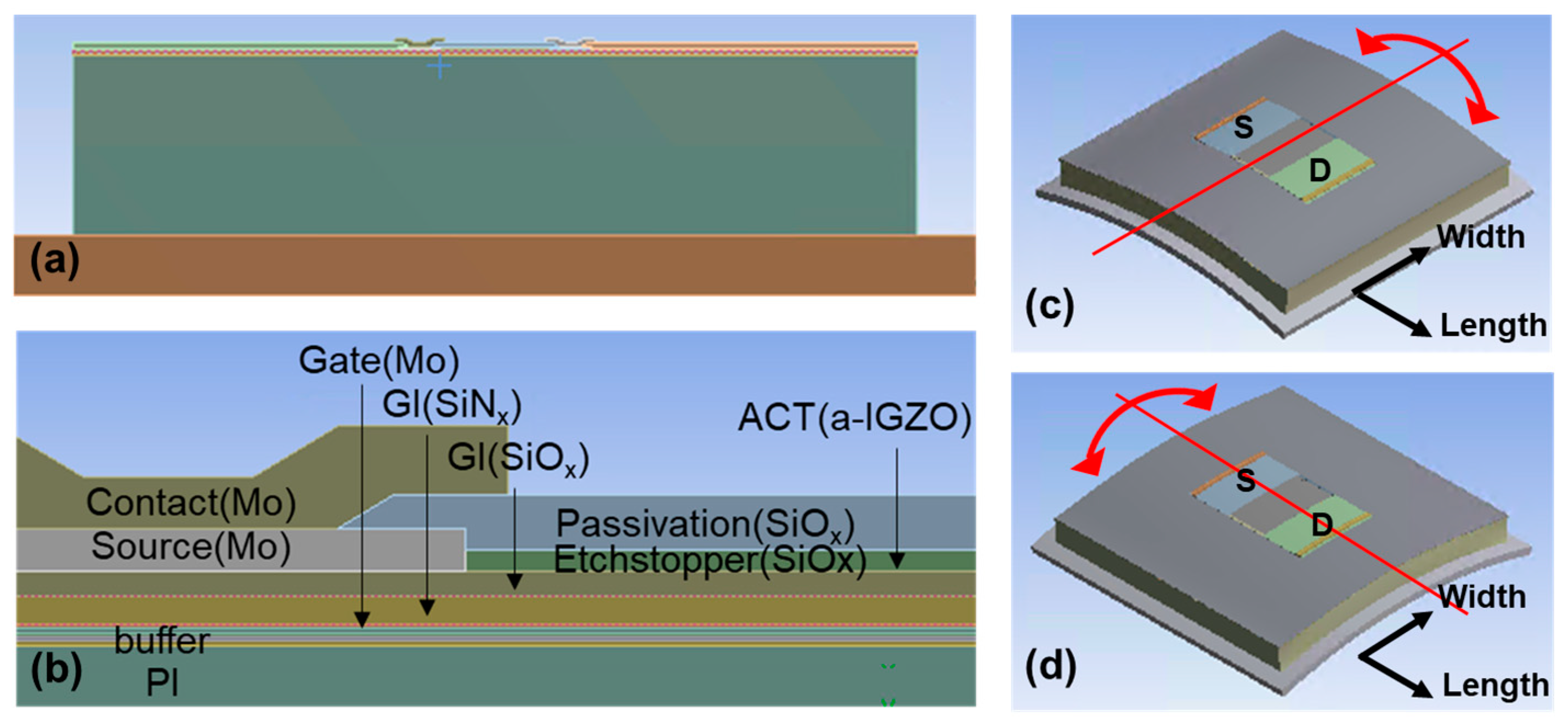
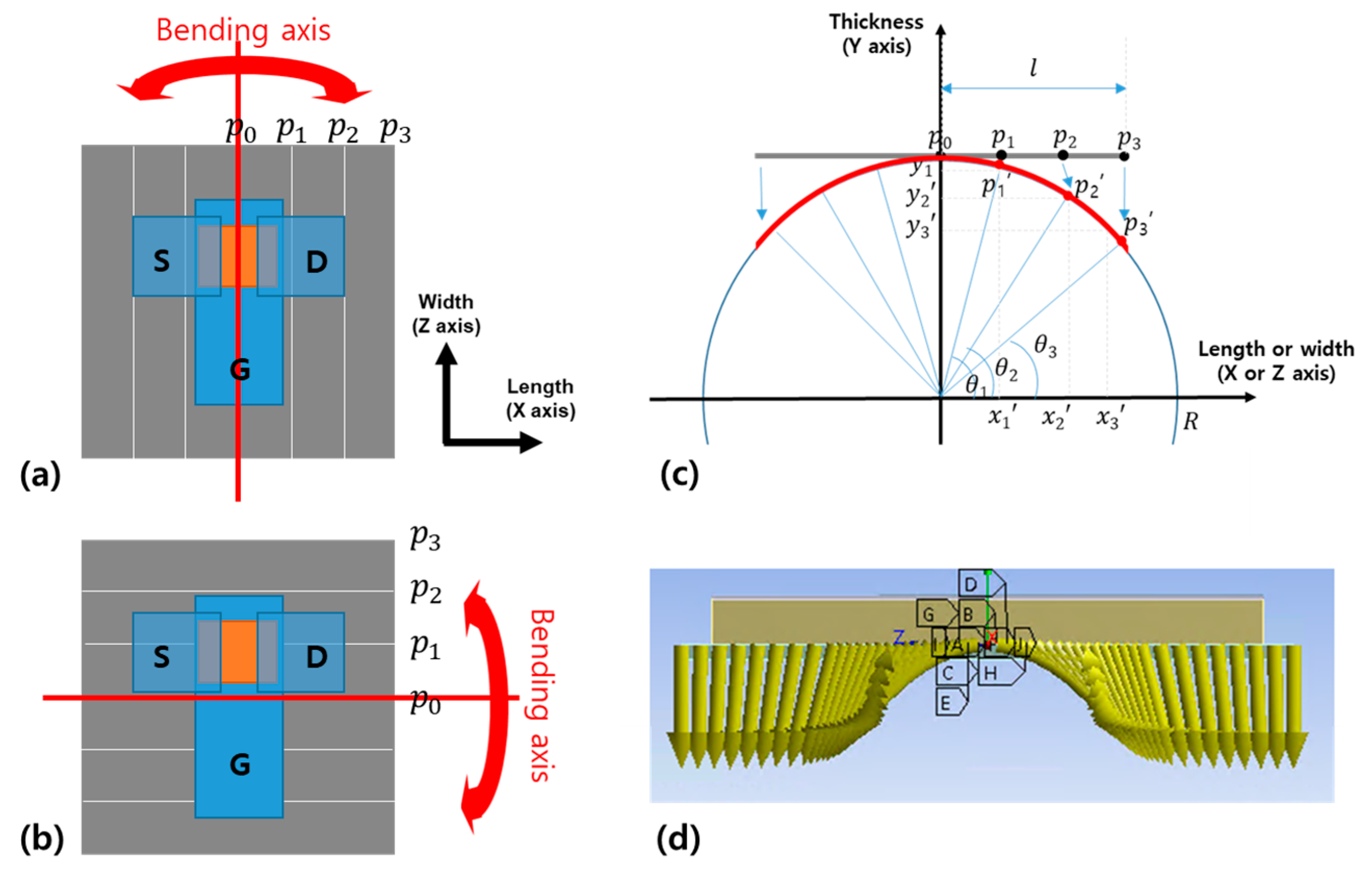
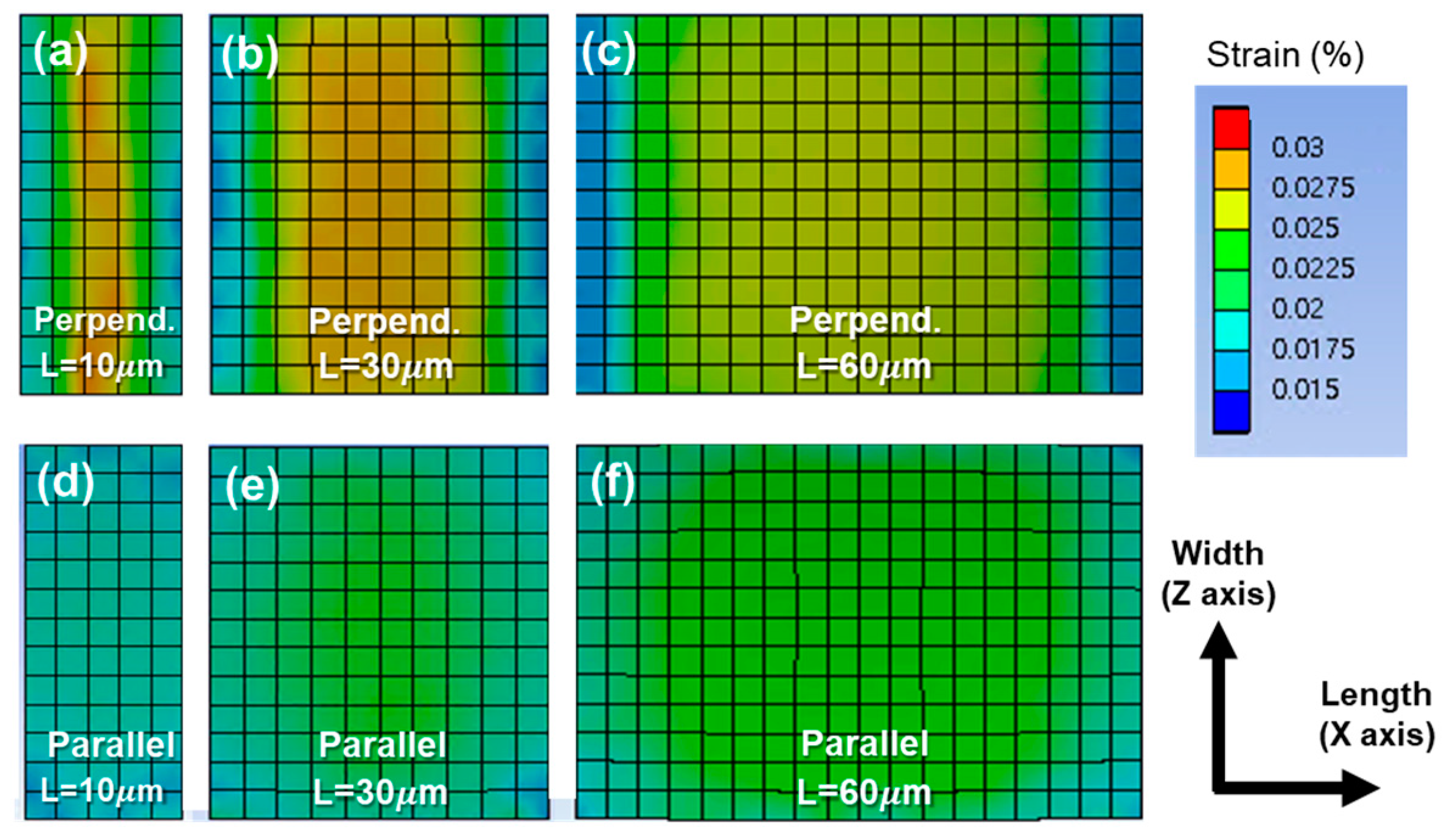

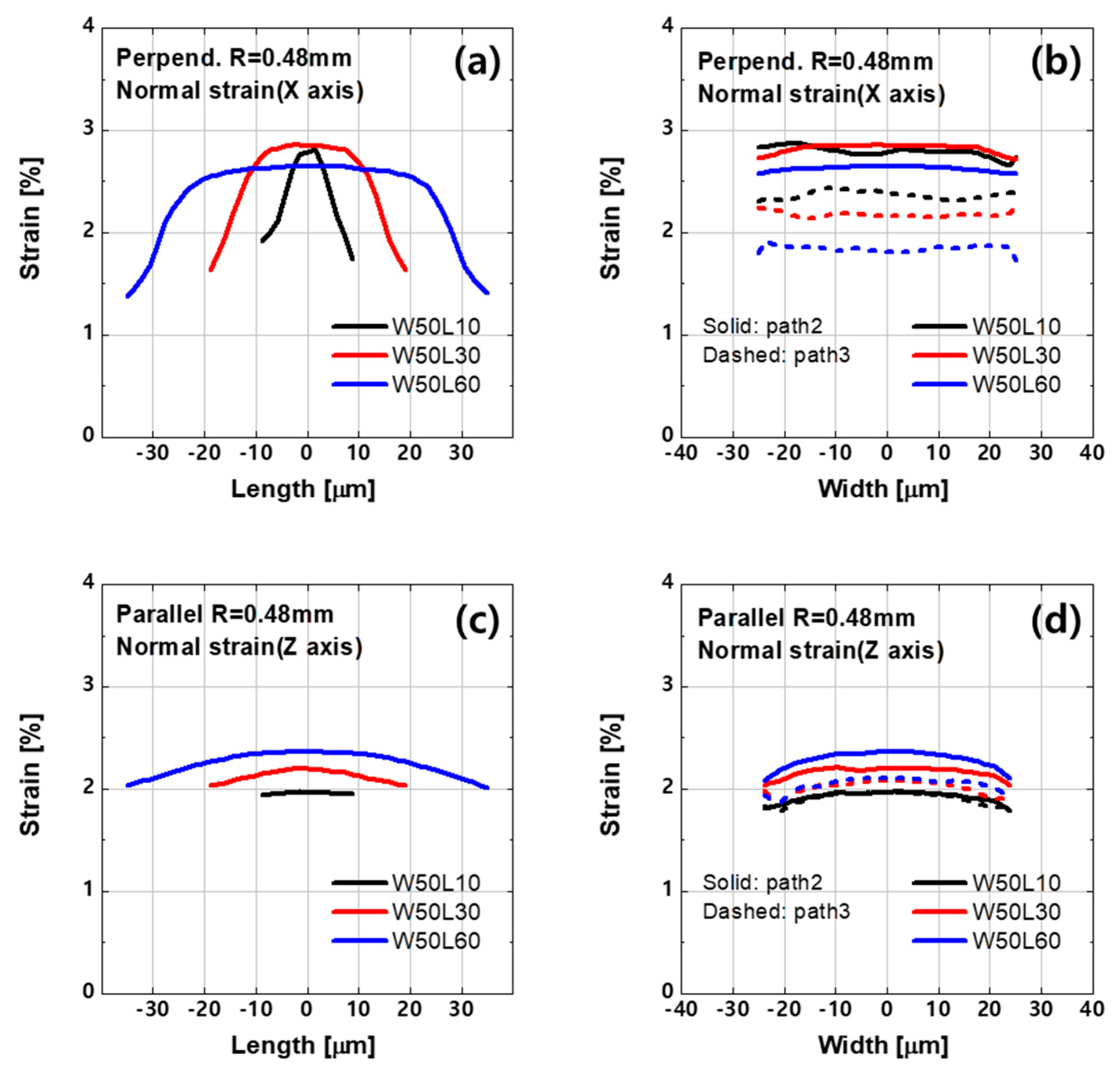
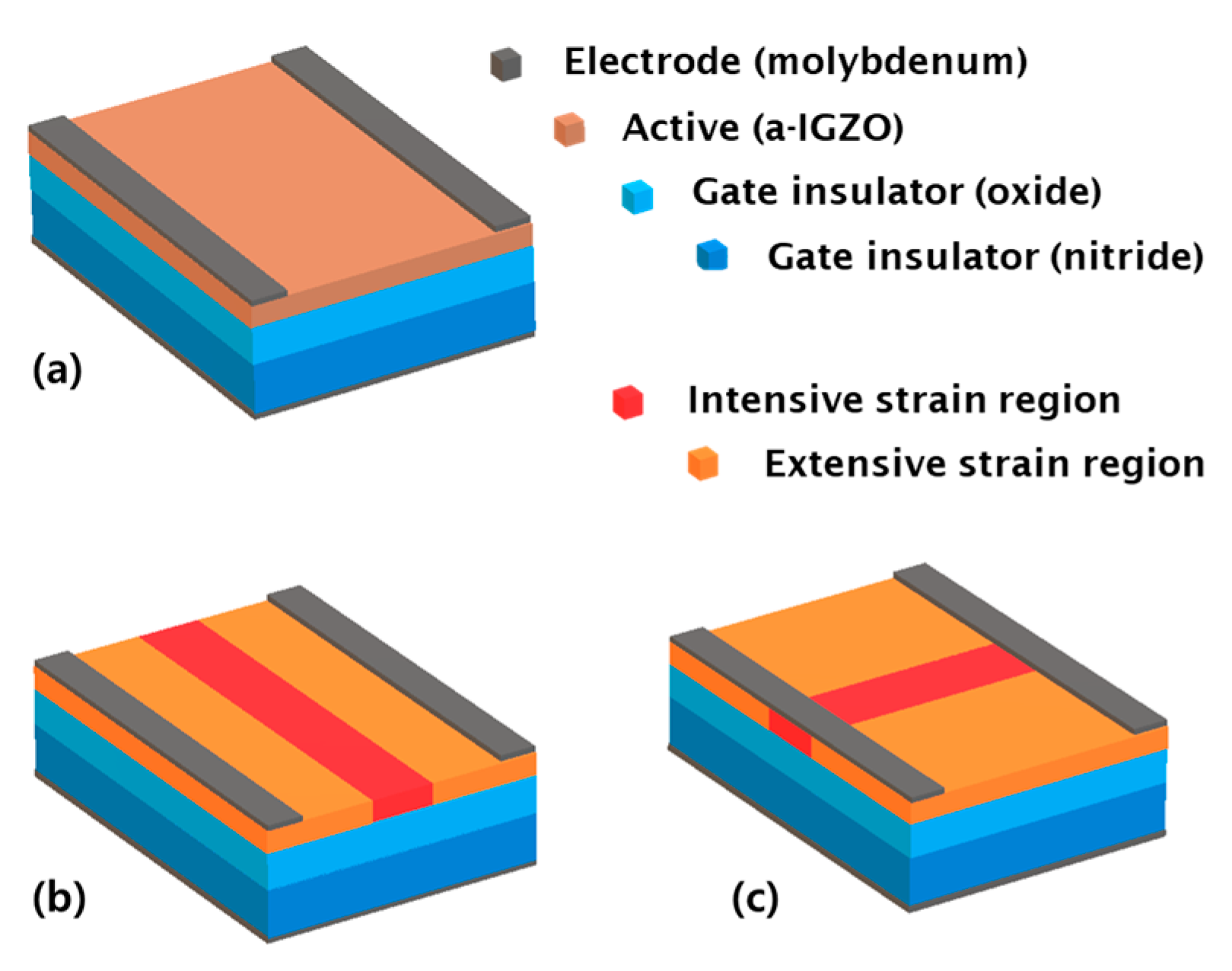
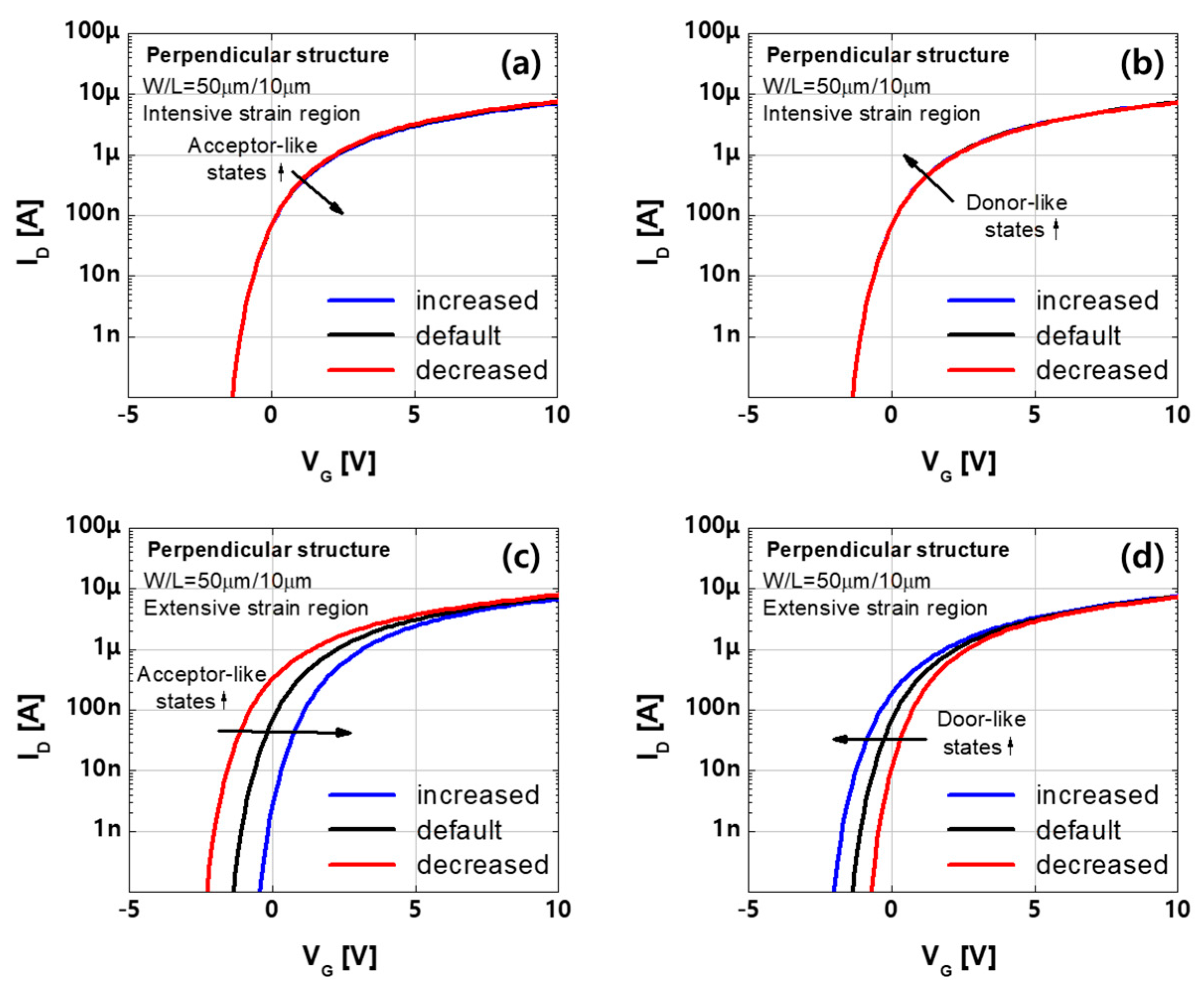
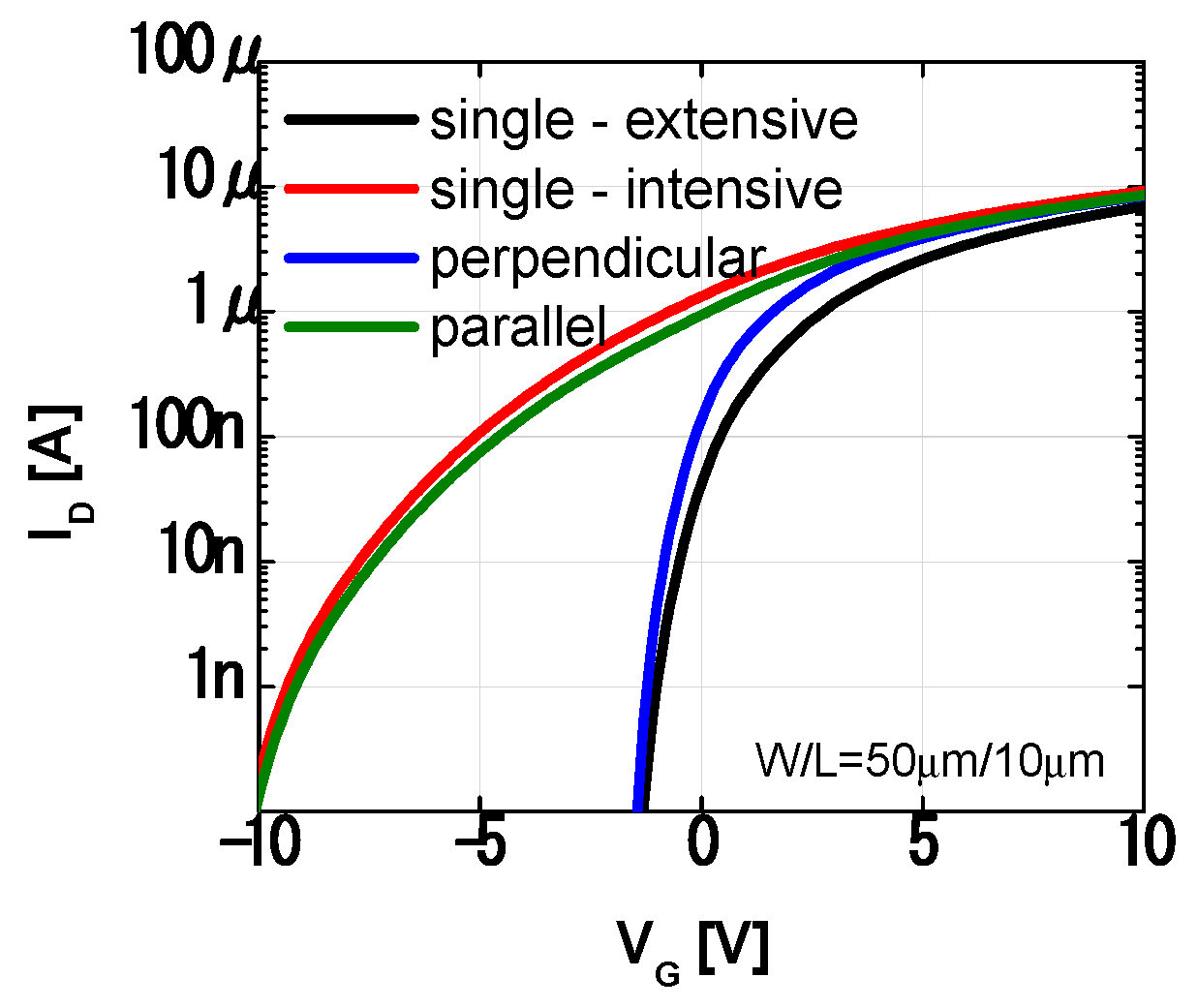
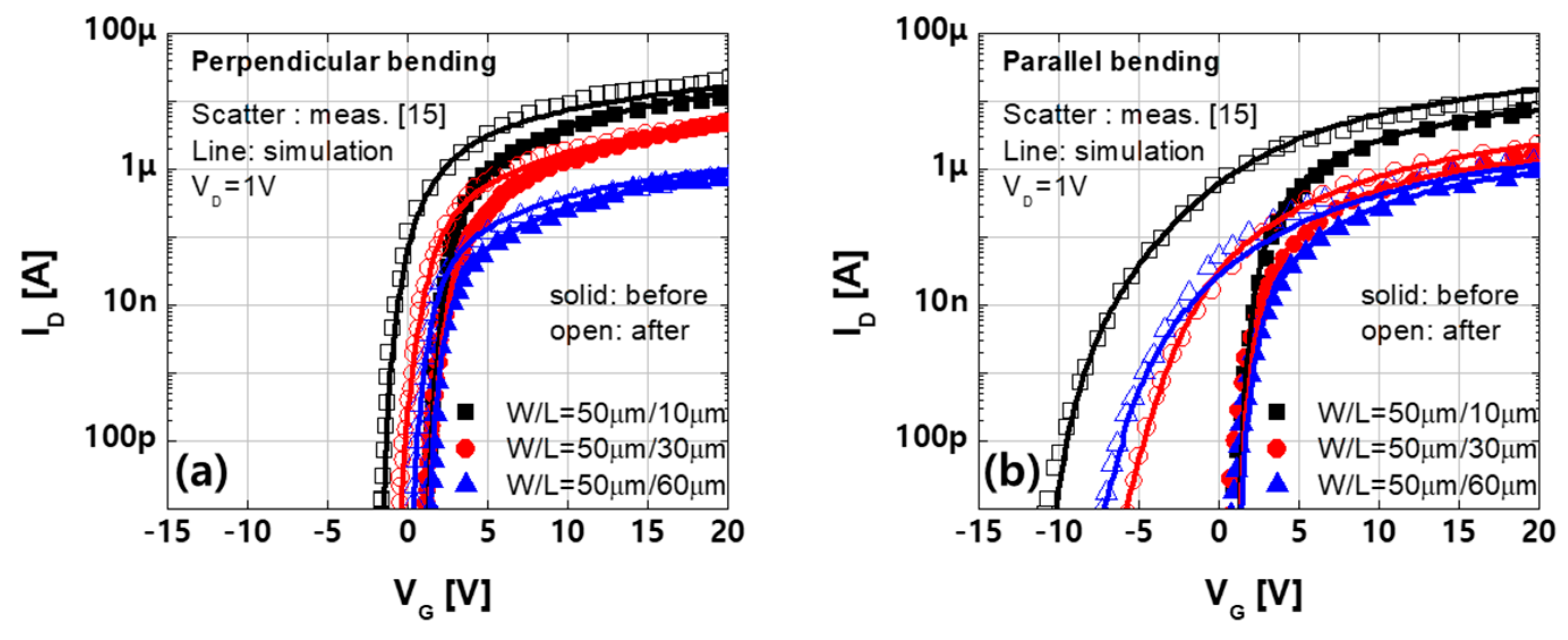


| Layer | Material | Thickness [nm] | Young’s Modulus [GPa] | Poisson’s Ratio |
|---|---|---|---|---|
| Active | a-IGZO | 20 | 130 | 0.36 |
| Gate insulator1 | SiOx | 150 | 70 | 0.18 |
| Gate insulator2 | SiNx | 100 | 250 | 0.25 |
| Electrode | Molybdenum | 60 | 315 | 0.30 |
| Substrate | Polyimide | 15000 | 2.5 | 0.40 |
| Status | Structure | Region | Trap | Channel Length | ||
|---|---|---|---|---|---|---|
| 10 µm | 30 µm | 60 µm | ||||
| Before bending | Single-region | - | NGD 1 | 3.0 × 1016 | 3.0 × 1016 | 3.0 × 1016 |
| NGA 2 | 1.0 × 1017 | 1.0 × 1017 | 1.0 × 1017 | |||
| After bending | Multi-region | Intensive | NGD | 1.0 × 1018 | 1.0 × 1018 | 9.0 × 1017 |
| NGA | 2.8 × 1017 | 2.8 × 1017 | 2.5 × 1017 | |||
| Extensive | NGD | 4.0 × 1017 | 3.4 × 1017 | 2.0 × 1017 | ||
| NGA | 2.2 × 1017 | 2.0 × 1017 | 1.6 × 1017 | |||
| Status | Structure | Region | Trap | Channel Length | ||
|---|---|---|---|---|---|---|
| 10 µm | 30 µm | 60 µm | ||||
| Before bending | Single-region | - | NGD | 3.0 × 1016 | 3.0 × 1016 | 3.0 × 1016 |
| NGA | 1.0 × 1017 | 1.0 × 1017 | 1.0 × 1017 | |||
| After bending | Multi-region | Intensive | NGD | 7.3 × 1017 | 7.4 × 1017 | 7.4 × 1017 |
| NGA | 1.0 × 1017 | 1.2 × 1017 | 1.2 × 1017 | |||
| Extensive | NGD | 7.0 × 1017 | 7.2 × 1017 | 7.2 × 1017 | ||
| NGA | 1.0 × 1017 | 1.0 × 1017 | 1.0 × 1017 | |||
Publisher’s Note: MDPI stays neutral with regard to jurisdictional claims in published maps and institutional affiliations. |
© 2021 by the authors. Licensee MDPI, Basel, Switzerland. This article is an open access article distributed under the terms and conditions of the Creative Commons Attribution (CC BY) license (https://creativecommons.org/licenses/by/4.0/).
Share and Cite
Choi, Y.; Park, J.; Shin, H. New Simulation Method for Dependency of Device Degradation on Bending Direction and Channel Length. Materials 2021, 14, 6167. https://doi.org/10.3390/ma14206167
Choi Y, Park J, Shin H. New Simulation Method for Dependency of Device Degradation on Bending Direction and Channel Length. Materials. 2021; 14(20):6167. https://doi.org/10.3390/ma14206167
Chicago/Turabian StyleChoi, Yunyeong, Jisun Park, and Hyungsoon Shin. 2021. "New Simulation Method for Dependency of Device Degradation on Bending Direction and Channel Length" Materials 14, no. 20: 6167. https://doi.org/10.3390/ma14206167
APA StyleChoi, Y., Park, J., & Shin, H. (2021). New Simulation Method for Dependency of Device Degradation on Bending Direction and Channel Length. Materials, 14(20), 6167. https://doi.org/10.3390/ma14206167






